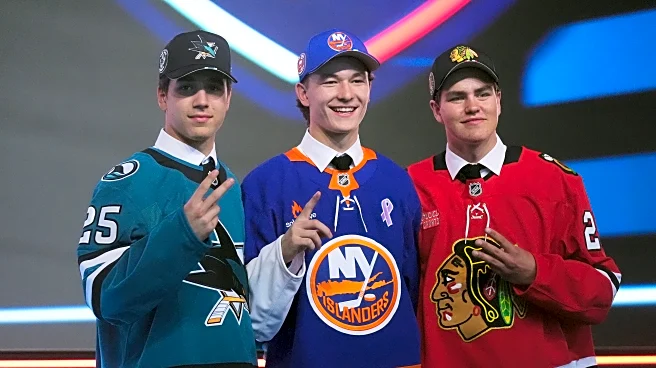What's Happening?
The NHL has announced its season-opening rosters, featuring three of the top five picks from the most recent draft. Matthew Schaefer, the No. 1 overall pick, has secured a spot with the New York Islanders following a strong training camp. Michael Misa, the No. 2 pick, will start the season with the San Jose Sharks, while Brady Martin, the No. 5 pick, has joined the Nashville Predators. Schaefer, a defenseman who recently turned 18, is set to play in the Islanders' lineup against Pittsburgh. The Sharks, in a rebuilding phase, have included Misa and Sam Dickinson, the 2024 No. 11 pick, in their roster. Meanwhile, Martin is practicing alongside established players Filip Forsberg and Ryan O'Reilly as Nashville aims to regain contender status.
Why It's Important?
The inclusion of top draft picks in the NHL season-opening rosters highlights the league's focus on integrating young talent into its teams. This move is significant for the franchises involved, as it reflects their commitment to developing future stars and potentially reshaping their competitive dynamics. For the Islanders, Sharks, and Predators, these young players represent hope for long-term success and a fresh approach to team strategy. The decision to keep these players on the main roster rather than returning them to junior teams indicates confidence in their readiness to contribute at the professional level. This development could influence other teams to prioritize youth in their roster decisions, impacting the overall landscape of the NHL.
What's Next?
As the NHL season progresses, the performance of these young draft picks will be closely monitored. Their ability to adapt to the professional level and contribute to their teams' success will be crucial. The Islanders, Sharks, and Predators will likely adjust their strategies based on the rookies' performances, potentially leading to shifts in team dynamics and playoff aspirations. Additionally, other teams may observe these developments and consider similar approaches in future drafts, emphasizing the importance of nurturing young talent. The success of these players could also impact their market value and contract negotiations in the coming years.
Beyond the Headlines
The integration of young players into NHL rosters raises questions about the balance between experience and youth in professional sports. It challenges traditional notions of player development and the timeline for reaching peak performance. This trend may lead to discussions about the ethical considerations of placing young athletes in high-pressure environments and the support systems necessary to ensure their well-being. Furthermore, the success of these players could inspire changes in scouting and training practices, emphasizing agility and adaptability over traditional metrics.












